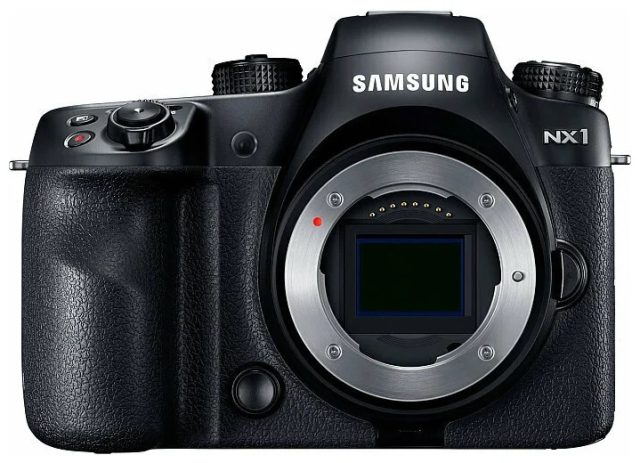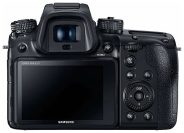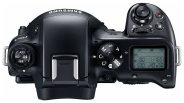Announced
Production status
System
Samsung NX1
APS-C AF digital mirrorless camera • Discontinued
Specification
| Format: | |
| APS-C | |
Imaging sensor: | 23.5 × 15.7mm CMOS sensor |
Resolution: | 6480 × 4320 - 28 MP |
Crop factor: | 1.53x |
Sensor-shift image stabilization: | - |
| Samsung NX [25.5mm] | |
| Shutter: | |
Type: | Focal-plane |
Model: | Electronically controlled |
Speeds: | 30 - 1/8000 + B |
| Exposure: | |
Exposure metering: | Through-the-lens (TTL), open-aperture |
Exposure modes: | Programmed Auto |
| Aperture-priority Auto | |
| Shutter-priority Auto | |
| Manual | |
| Physical characteristics: | |
Weight: | 550g |
Dimensions: | 138.5x102.3x65.8mm |
Manufacturer description
RIDGEFIELD PARK, N.J. – Sept. 15, 2014 – Samsung Electronics America, Inc. (SEA), announces today the launch of the NX1 SMART Camera. This new flagship model combines professional image quality with cinema quality Ultra High Definition (UHD) / 4K resolution video recording and industry-leading SMART connectivity. Samsung also expands its line of professional-grade “S” lenses with the introduction of a new telephoto lens, the NX 50-150mm F2.8 S OIS lens.
“The NX1 is the new flagship in our award-winning NX line-up. It brings together our SMART camera technology, new 4K video capabilities and Samsung’s fastest AF system to date in a lightweight, portable body. This blend of cutting edge imaging technology appeals to a wide variety of photographers, and makes it one of the most competitive models in its class,” said Ron Gazzola, Vice President of Marketing, Digital Imaging, Samsung Electronics America. “The combination of the new Samsung 50-150mm F2.8 S lens and NX1 delivers an unrivalled shooting experience that gives users the confidence that they’re taking the best images or video in any situation.”
Blazing Fast Speed and Superb Image Quality
The NX1 boasts an all new, best in class, 28MP BSI CMOS sensor, which supports Samsung’s fastest autofocus system to date, the NX AF System III. Photographers can quickly focus on subjects, making this camera ideal for photographing a football player as they run down the field or baseball action at home plate. Developed utilizing Samsung’s advanced semiconductor technology, the back side illuminated sensor is capable of gathering more light than conventional CMOS sensors. The new NX AF System III features 205 Phase Detect AF points covering 90 percent of the frame, allowing photographers to quickly focus on their targets. This quick focusing ability allows the camera to achieve 15FPS of continuous shooting while continuously tracking focus. The system also employs a patterned AF Assist Beam that reaches up to 15m and will help to more accurately capture clear photos in low light.
The NX1 also incorporates a new DRIMe V Image Processer that delivers superior color reproduction and works with the camera’s built-in Adaptive Noise Reduction technology to help retain details and remove noise from photos captured at high ISO’s. The advanced algorithm also analyzes details and color in each photo, making sure users always have the clearest image.
Wide Phase Detection gives the NX1 the ability to instinctively track subjects almost anywhere in the frame, regardless of their location. Photographers can capture even the briefest of moments. There is no need to re-compose a shot – they can simply focus and shoot immediately, allowing for extreme speed and flexibility. This technology will be of particular interest to those who love to shoot video, as the NX1 supports the use of Phase Detect AF during movie recording, so that results are stable and steady.
The new Samsung Auto Shot highlights the innovation available in the NX1. Using the DRIMe V Image Processor and an advanced algorithm, the NX1 will track a baseball as it travels to a player, allowing photographers take crisp images of the moment a ball connects with a bat. While these shots can often be difficult to take, the NX1 removes any concern by accurately predicting the right time to trigger the shutter and capture a full-resolution image.
As the only compact system camera on the market with a top deck LCD panel, photographers can easily confirm camera settings, including aperture, shutter speed, ISO, white balance, AF settings, drive and battery life with one glance.
Cinema Quality Video
Videographers and filmmakers can easily shoot cinema-quality video straight from the NX1. Utilizing the next generation HEVC codec, the NX1 is capable of recording smooth and immersive UHD/4K (DCI Standard) video. Users can easily save files directly to the memory card in the camera, eliminating the need to carry hefty external 4K recorders. This is made possible by a built-in HEVC Codec (H.265).
With a myriad of input, output and connectivity options, users will be able to customize their NX1 for their unique recording needs. Additionally, using Samsung’s SMART technology, users can also share their videos directly to any Samsung UHD television via Wi-Fi.
The NX Lens Line-up Gets Faster
Expanding upon Samsung’s premium line of “S” lenses, the new Samsung 50-150mm F2.8 S lens is the second in the series and affords photographers the opportunity to capture telephoto images with crisp clarity and tack sharp focus in a variety of scenarios. Its fast aperture provides excellent low light performance and beautiful bokeh, making it perfect for sports, nature and wedding photography. The lens features an Ultra-Precise Stepping Motor (UPSM), improved from the conventional Stepping Motor (SM), it is three times more precise in its ability to control and focus on subjects. Photographers can capture sharp photos at low shutter speeds using advanced multi-axis Optical Imaging Stabilization (OIS) with four-axis control and a six-axis sensor array. These sensors detect camera motion, and help the lens to make the precision corrections necessary.
The new telephoto lens features a dust and water resistant build making it both durable and reliable. All of the lens controls, focus, zoom and OIS, are located in a single “function zone” on the side of the lens, making it easy to control.
Smart Connectivity, Tag & Go
Building on the successes of Samsung's market leading SMART Camera technology, the NX1's NFC and Wi-Fi capabilities offer the next-generation of connectivity, making it is easier than ever to take advantage of a host of intuitive sharing features. The ‘Tag & Go’ function lets users tap and share memories instantly and easily, pairing the NX1 with NFC enabled smartphones and tablets. Additionally, the NX1 incorporates Bluetooth 3.0 for an always-connected experience with a mobile device. After authenticating the connection via Bluetooth, the NX1 is capable of collecting important time, date and location data and automatically imports it into the image’s metadata. Once authenticated, the connection will automatically switch to a Wi-Fi connection for data transfer.
The Photo Beam feature allows the transfer of images or videos to a smartphone or tablet by simply touching the two devices together with no other configuration needed. MobileLink lets users select multiple images to send to four distinct smart devices at one time, so everyone can treasure photos without the need to take repetitive shots on each individual device. AutoShare sends every photo you take instantly to your smartphone or tablet and the Remote Viewfinder Pro function enables control of the NX1 from a smartphone, allowing the user to zoom and snap shots remotely yet still have full visibility of the scene, opening up new photographic possibilities. Manual settings can still be accessed, including shutter speed and aperture, so that photographers can retain camera control yet have another option as to how they want to frame their shot.


